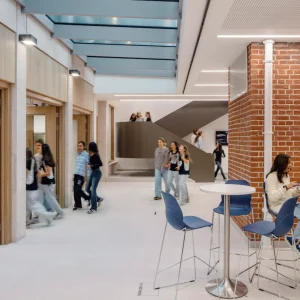Designed by SOM’s Chicago and New York offices and completed in 1981, the Hajj Terminal in Jeddah, Saudi Arabia becomes a temporary city for Muslims who decamp from planes and await transportation to the holy cities of Mecca and Medina during the six weeks of the Islamic faith known as ‘Hajj’.
SOM created a series of tent-like structures beneath which up to 80,000 pilgrims can be accommodated at a time. The 120-acre terminal consists of two identical roofed halves separated by a landscaped central mall. The first half of the terminal contains air conditioned buildings; the second half is a vast, open-sided temperate waiting and support area. The visually arresting Teflon-coated fiberglass roof structure consists of 10 modules of 21 semi-conical fabric roof units. Each module is supported by 147 feet tall steel cables along the rooftop. Nearly 40 million travelers have passed through the Hajj Terminal since its completion.
The AIA Twenty-Five Year award, recognizing architectural design of enduring significance, is conferred on a project that has stood the test of time for 25 to 35 years as an embodiment of architectural excellence. Projects must demonstrate excellence in function – in the distinguished execution of its original program and in the creative aspects of its statement by today’s standards.
The award jury commented, “The architects created a highly sustainable project well ahead of the green movement. The terminal presents a sense of place, ecology, economy of means, and culture – not imposing on but learning from the local culture and environment.”
The Hajj Terminal has also received a 1983 AIA National Honor Award, the 1983 Aga Khan Award for Architecture and a 1981 Progressive Architecture award.





